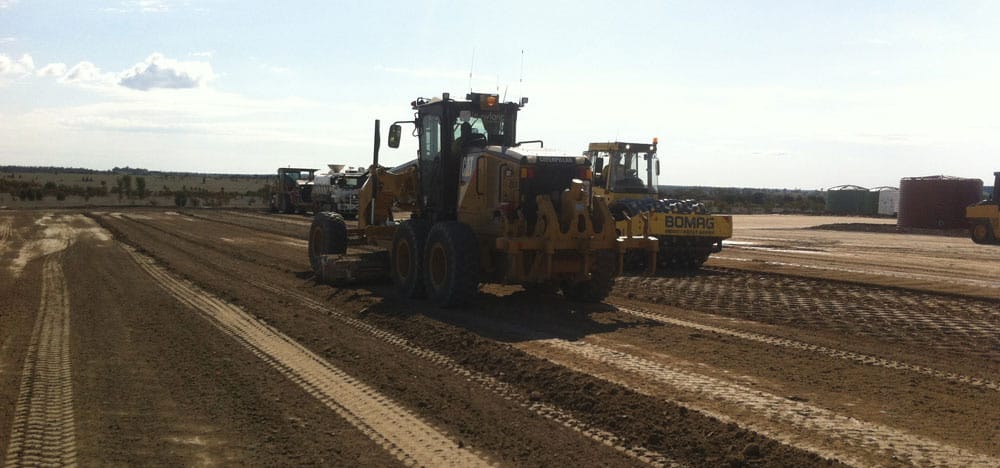Soil stabilization is a process by which the strength, stiffness and bearing capacity of road foundations are improved by either mechanical or chemical means.
Such mechanical and chemical stabilization methods are able to counter the swelling potential and other volumetric changes of expansive soils (sub-grade) by improving soil impermeability and incompressibility. The soil stabilization process is, therefore, one that solves issues, which would otherwise be problematic for road builders and the development of infrastructure.
Soil Stabilization Methods:
1. Mechanical Soil Stabilization
Soil stabilization by mechanical means is a process by which the composition of the subgrade is altered either through mixing, compaction or substitution. For example, the subgrade may be mixed with other soils or materials, or the soil density of the subgrade may be increased by means of compaction, and/or the subgrade material may be replaced with other soils or materials. Apart from compaction, these mechanical methods are very costly. There is also a high carbon footprint and adverse environmental effects associated with the transportation of heavy road materials.

Are environmental regulations, health and safety concerns or potential profit loss a concern right now?
Geogrids are another example of mechanical stabilization. The implementation of geogrids is for the improvement of road sections by providing tensile reinforcement, confinement, lateral spreading reduction, separation, construction uniformity, and reduction in strain. The product is laid either over the entire pavement or only at the concrete slab joints and small potholes. This process is costly and might only be justified in the event of adverse pavement, climatic and soil conditions.
2. Chemical stabilization
Chemical stabilization, on the other hand, is a process by which chemicals such as cement, fly ash, lime, chloride compounds or a combination of these are introduced to pavement materials. By introducing these chemicals, the physical and chemical properties of soil are altered, allowing stabilization to occur.
Hydrated lime (Ca(OH)2) is used to improve the strength, stiffness and durability of fine-grained soils. It can also be used as a soil stabilizer in the base course of concrete pavement. The addition of lime to soils results in a higher density under higher optimum moisture content compared to that achieved in untreated soil. Lime also decreases a soil’s plasticity index.
Bitumen based substances such as asphaltic bitumen, or tar emulsions are sometimes used for soil stabilization, particularly for stabilizing the sub-grades or bases of roads carrying higher loads. However, this is only useful in granular sandy soils under dry conditions.
Cement is composed of calcium silicate (Ca2SiO4) and calcium aluminates that when combined with water, hydrate to form the cementing compounds of calcium silicate hydrate (C-S-H), calcium-aluminate hydrate, as well as excess calcium hydroxide (lime). The resulting cementitious material with calcium hydroxide produced is useful in stabilizing both granular and fine-grained soils, as well as aggregates and miscellaneous materials. Despite this, these cementitious bonds are easily broken down by both freeze-thaw cycles and under continual loading.
GRT Soil Stabilization:
Global Road Technology (GRT) Managing Director Troy Adams said its products allow the use of in situ materials no matter their structure or constituents. This reduces the need for external materials to be introduced in the construction process. GRT7000 can be used where a high UCS capacity and low dosage rates are required. Testing has shown that even dosage rates as little as 0.7% by mass can yield load-bearing results of over 6 MPa. As such, GRT7000 can be used for sealing or stabilizing haul roads, side tracks, car parks, construction or military camps, container hardstands, railroad yards, and temporary landing areas. Unlike traditional soil stabilization, the use of GRT stabilizing agents allows in-situ materials or even old pavements to be utilized in the creation of new roads. The economic and environmental outcomes are deeply palpable when minimal amounts of in situ soils can be utilized to form new roads.
For more information on Global Road Technology or Soil Stabilization please contact us
Troy Adams
Troy Adams is the Managing Director of Global Road Technology (GRT) Specialising in Engineered Solutions for Dust Suppression, Erosion Control, Soil Stabilisation and Water Management. A pioneering, socially conscious Australian entrepreneur, Troy Adams is passionate about health and safety and providing innovative solutions that are cost-effective to the mining industry, governments and infrastructure sectors. Troy is also a tech investor, director of companies like Crossware, Boost, Hakkasan, Novikov and more.
MORE INDUSTRY ARTICLES
April 12, 2024
Fortescue Flicks-On QLD Electrolyser Plant
April 11, 2024

